They are black, yet colorful as a rainbow. Specialized structures in their feathers reflect and refract light to produce iridescence. Grackles are abundant in our south Florida neighborhood. We host two resident species, Boat-tailed and Common Grackles. Boat-tailed Grackles' eye color may vary irregularly from yellow in some of the northern races to dark brown or almost black further south.
Boat-tailed Grackles range along the Atlantic and Gulf coasts as well as the entire Florida Peninsula. These large grackles (males measure 16 1/2 inches/42 cm) breed in colonies in marshes as well as suburban landscape trees. A few older alpha males compete to maintain their dominance over a group of females and subordinate males.
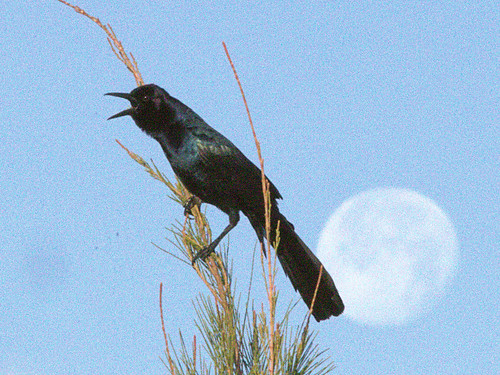
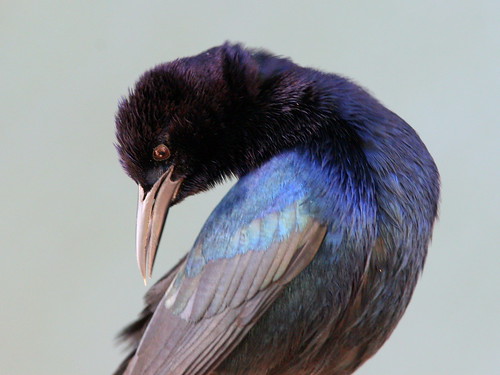
During the winter they gather in same-sex flocks, and in early spring begin courtship and the males compete for dominance with elaborate displays. They sometimes fight viciously, but usually it is all a show:
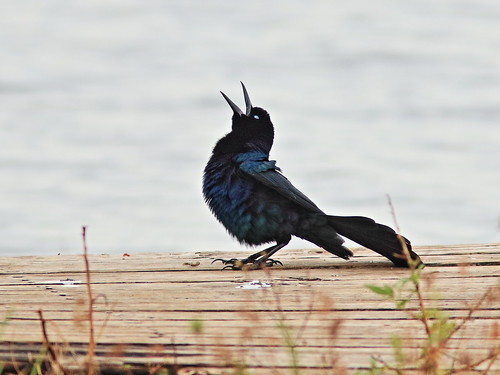
Males displaying:
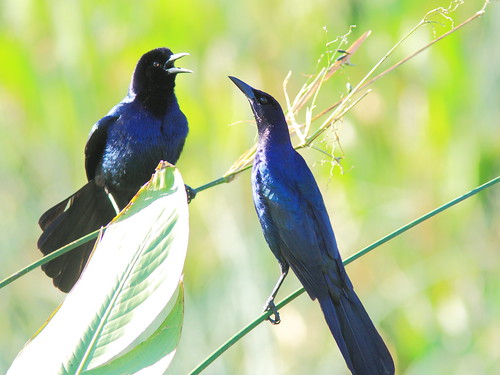
Crossed swords:
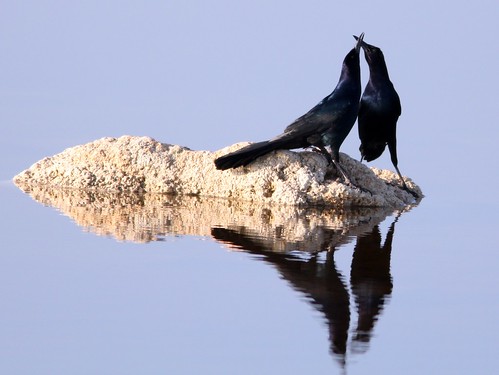
The male often closes his nictitating membrane during displays:
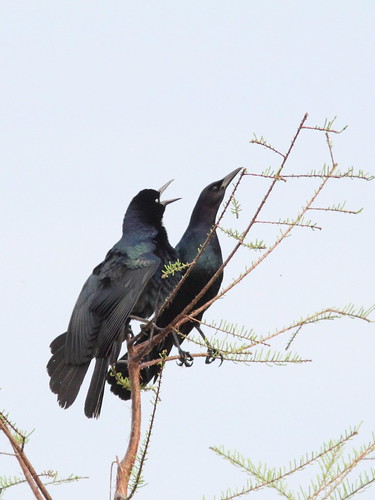
Group display
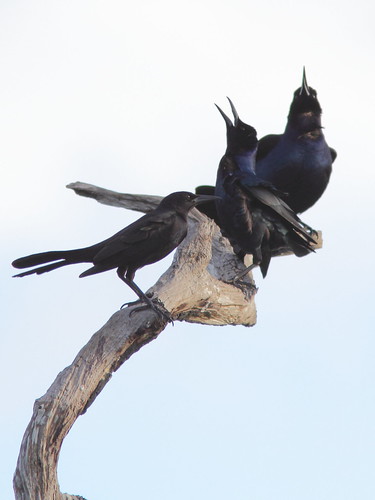
Male eating millipede:
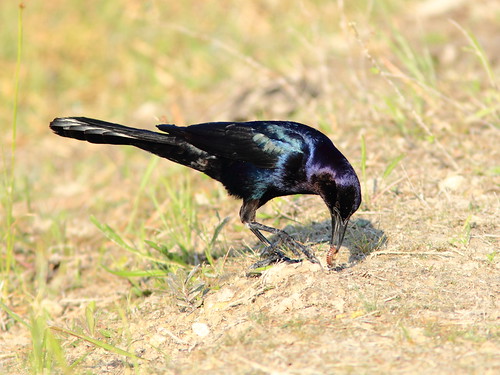
They often gather at the water's edge:
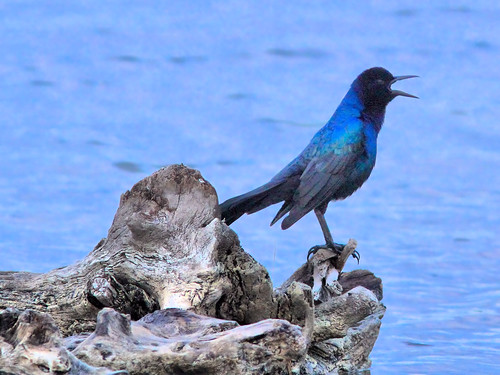
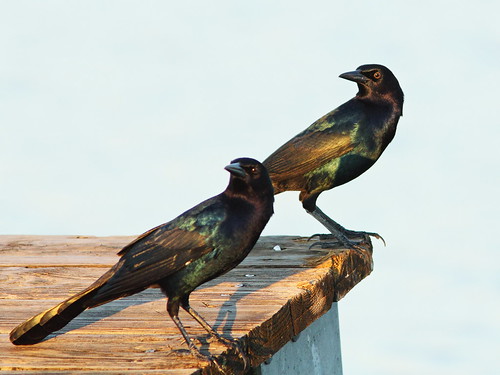
The female Boat-tailed Grackle is smaller (14 1/2 inches/37 cm) and so different in appearance that some early observers thought it to be a different species:
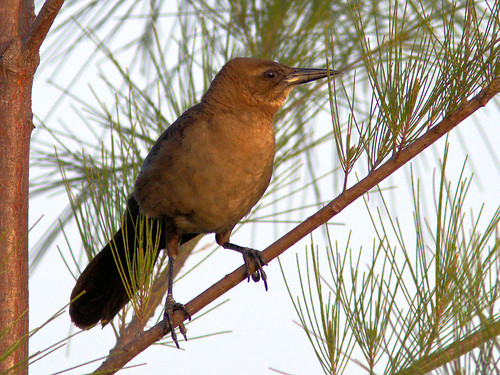
Female boat-tail reflection:
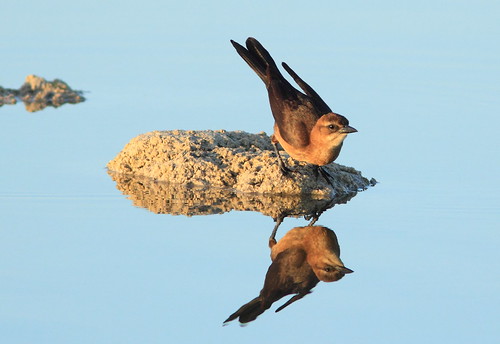
Female Boat-tailed Grackle and waning gibbous Moon:
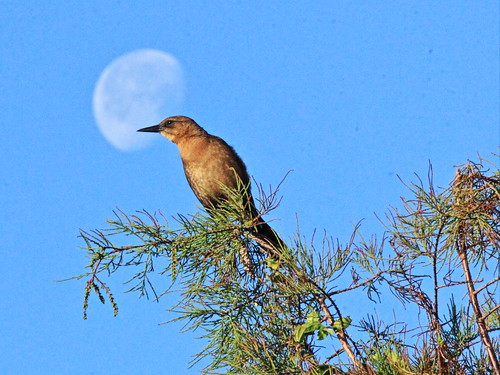
Common Grackles breed all across the eastern two-thirds of the US and Canada. They are very adaptable and have expanded their range westward as land has been cleared and developed. They are omnivorous but their taste for grain has made them serious agricultural pests. They especially like to uproot corn as it sprouts. Their diet includes eggs and nestlings of native birds and are known to kill adult birds of smaller species.
They are smaller (12 1/2 inches/32 cm), even more vividly iridescent than Boat-tails and have yellow eyes:
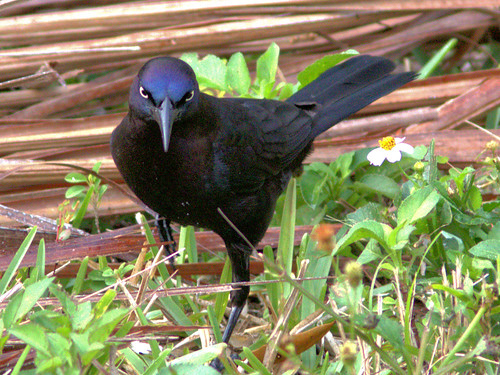
Note the pattern of iridescence of our local "Purple" Grackle, a race of the Common Grackle which has a blue back (another race, the "Bronzed" Grackle reflects a glossy brown) :
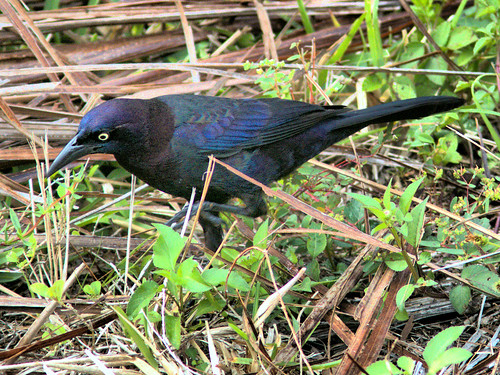
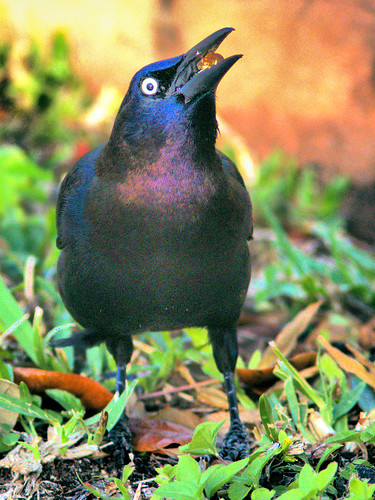
"Bronzed Grackle" is found in the northeastern, north central and western US:
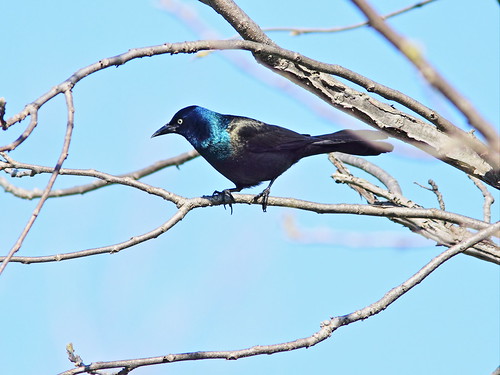
In Illinois at feeder:
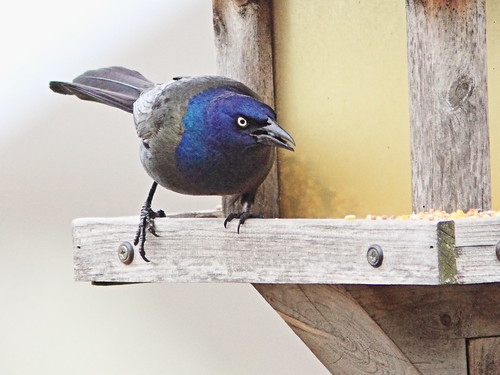
Two male Boat-tailed Grackles display on a fence rail along the boardwalk at a local nature preserve:
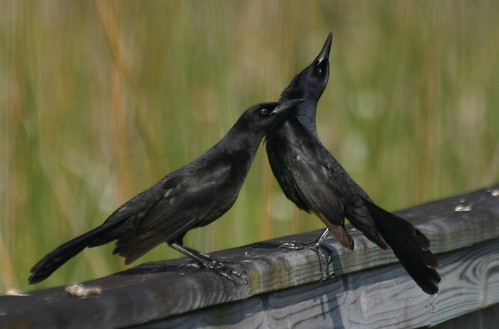
= = = = = = = = = = = = = = =
Linking to Misty's CAMERA CRITTERS,
Linking to Eileen's SATURDAY'S CRITTERS,
Linking to GOOD FENCES by Gosia
Linking to SKYWATCH FRIDAY by Yogi, Sylvia and Sandy
Linking to WEEKEND REFLECTIONS by James
Linking to BirdD'Pot by Anni
Linking to Wild Bird Wednesday by Stewart
Linking to Wordless Wednesday (on Tuesday) by NC Sue
Linking to ALL SEASONS by Jesh
________________________________________________
Please visit the links to all these memes to see some excellent photos on display
________________________________________________
On a lake only a 20 minute drive from our south Florida home, an unexpected sight unfolded before our eyes. First a few and then scores of Wood Storks descended upon a rookery. They displaced some of the former resident egrets, other herons, cormorants and Anhingas.

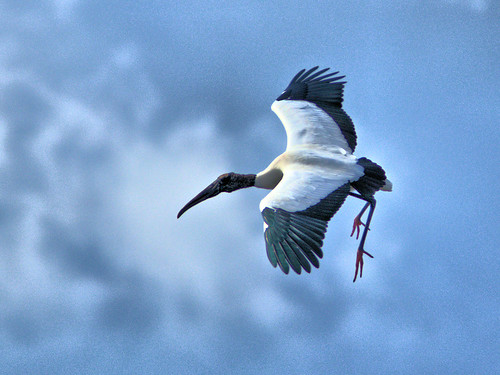

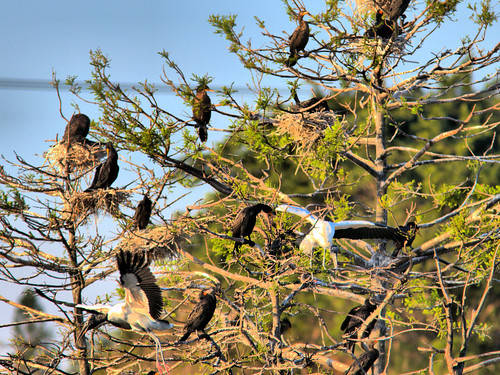
Eventually, 50 to 60 storks occupied 20 or more nests and my estimate is that they have produced over 30 young.
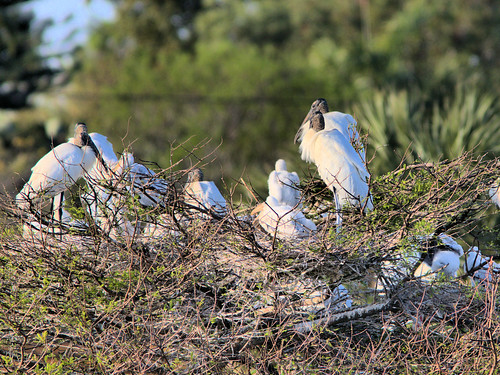
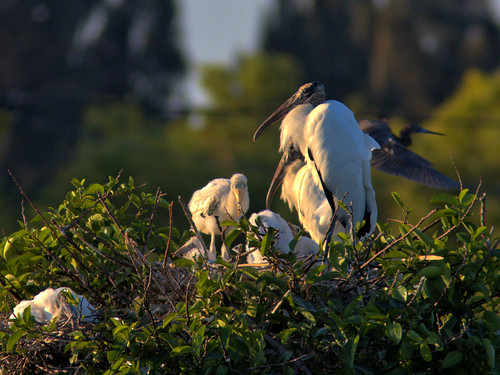
According to Cornell Lab of Ornithology eBird reports, this was a milestone, the first time in over 10 years that more than a few had been seen together within miles of this location.
When we moved to south Florida from New Mexico in 2004, Wood Storks were common breeders and visitors to our back yard lake. In my October, 2014 blog, "Wood Storks: Missing but not Endangered" I discussed the reason for the sharp decline in the Wood Stork population in south Florida:
" Drainage, filling of sloughs and development have altered the natural cycle, and aberrant rainfall patterns have complicated this balance. Summer drought or early onset of the wet season produce adverse conditions. Prolonged drought kills off the fish and their populations may take more than a year to recover even if water conditions are favorable. The 2012 wet season had much greater rainfall than normal, which was very favorable, but heavy rains during late winter reversed the drying process and dispersed prey, accounting for their failure to produce young during 2013."
The post also contains this photo, taken in 2010, of juvenile Wood Storks in our local wetlands:
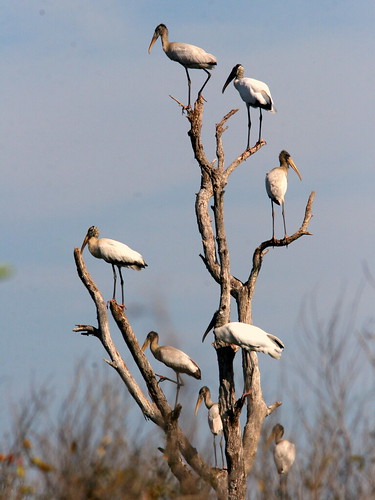
In a 2012 update to an earlier blog, "Struggling Storks" (October 5, 2010) I pointed out:
"Although the number of Wood Stork nests outside of South Florida have increased from 1817 in the 1970s to 5491 in the 2000s, the number of nests in South Florida have not recovered, ranging from from 2406 to 2367 over the same period. Nationally the percentage of nests at Corkscrew Swamp declined from 34-37% to only 8% of the US total. There has been total nesting failure at Corkscrew since 2010."
Despite the continuous decline and virtual disappearance of breeding Wood Storks in south Florida, in 2016 the US Fish and Wildlife Serve proceeded to remove the Wood Stork from the list of Endangered Species.
Thanks to more favorable weather conditions this past year (dryer in late summer which produced lower water levels), the local newcomers seem to be finding enough food for their youngsters. Tactile feeders, the storks depend upon lower water levels to concentrate their prey and shallow enough to allow them to keep their nostrils above the surface.
VIDEO (01:24): Wood Stork foraging in my back yard. If video fails to load, visit THIS VIMEO LINK
Wood Stork foraging from Ken Schneider on Vimeo.
This immature Wood Stork has a light bill and its head is not yet completely bald:
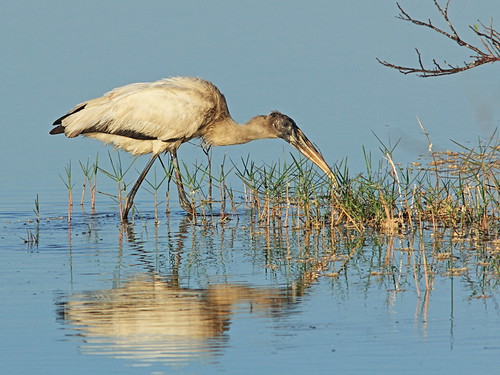
An adult stork rests along the boardwalk at the local Library wetlands:
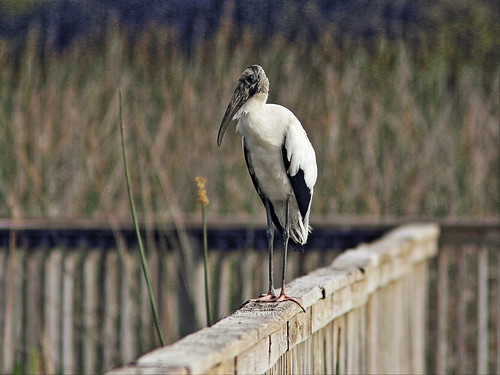
= = = = = = = = = = = = = = =
Linking to Misty's CAMERA CRITTERS,
Linking to Eileen's SATURDAY'S CRITTERS,
Linking to GOOD FENCES by Gosia
Linking to SKYWATCH FRIDAY by Yogi, Sylvia and Sandy
Linking to WEEKEND REFLECTIONS by James
Linking to BirdD'Pot by Anni
Linking to Wild Bird Wednesday by Stewart
Linking to Wordless Wednesday (on Tuesday) by NC Sue
Linking to ALL SEASONS by Jesh
________________________________________________
Please visit the links to all these memes to see some excellent photos on display
________________________________________________
We venture out on the local wetlands before sunrise nearly every morning. As the rainy season approaches we must keep an eye on the weather.
Rain threatened on April 10:
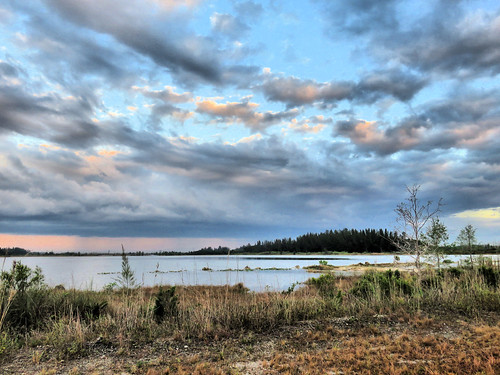
The next morning, skies were crystal clear. About fifteen minutes before sunrise (and only a half hour after it officially became "full"), the Pink Moon was plunging into the lake. Note the shadow of the earth a few degrees above the distant horizon.
The moon is not really pink, but it was so named by Native Americans because it signaled the spring season when Pink Phlox would blanket the landscape. The pink in the atmosphere in this photo is probably due to the presence of ash and smoke particles produced by a nearby wild fire:
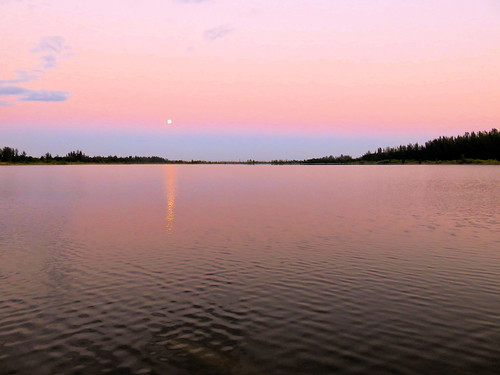 Depending upon the season, the birds we see are mostly predictable. I never have high expectations but am open to discovery and simply enjoy the sounds and sights of the birds and other wild things as they awake and welcome the cool morning air. Yet, almost every morning offers an opportunity to see something new.
Depending upon the season, the birds we see are mostly predictable. I never have high expectations but am open to discovery and simply enjoy the sounds and sights of the birds and other wild things as they awake and welcome the cool morning air. Yet, almost every morning offers an opportunity to see something new.
A Gray Squirrel, perched on a neighbor's fence munching on an acorn, wishes us luck as we pass by:
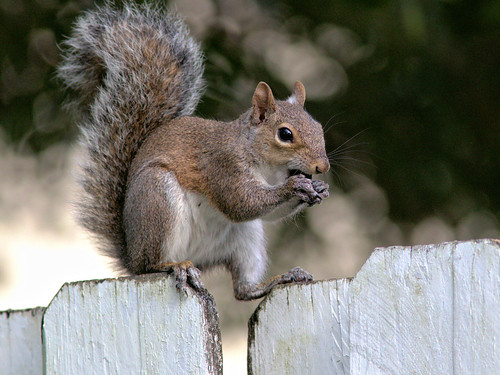
One morning this past week I was photographing two pairs of Green Herons as they cooperatively built their nests. One member of each pair (presumably the female) sat on the nest site and accepted sticks which were gathered by her mate:
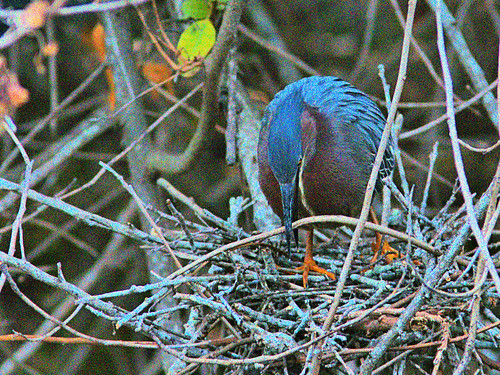
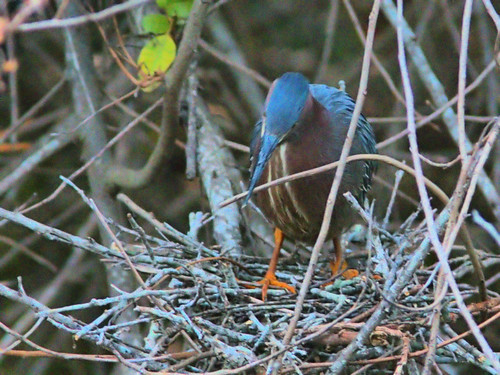
This pair took a break and cuddled up:
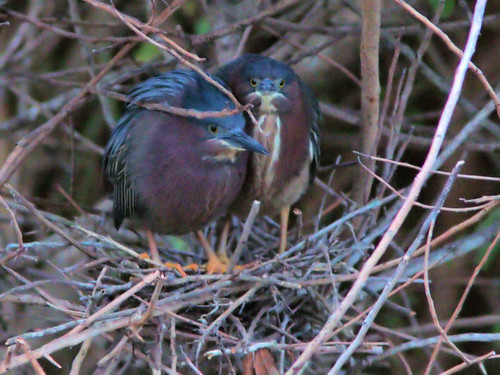
There were some tender interactions as the sticks were brought in and put in place. Here, a male presents a small stick to his mate as she stands over her newly laid first egg:
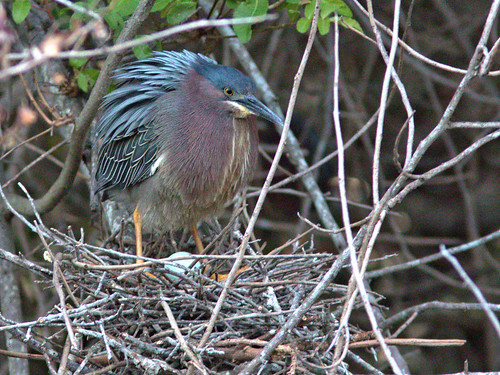
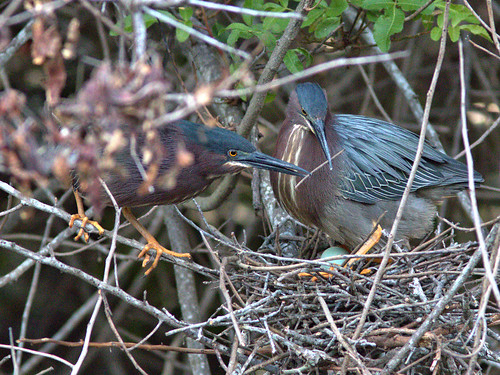
She accepts it and he gives her a friendly peck:
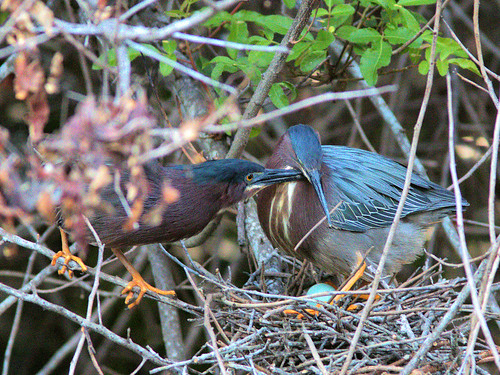
Usually shy and reclusive, a Pileated Woodpecker landed on the ground near me and searched for some sort of food at the base of a Live Oak. The bird's red forehead and face stripes identified it as a male. Before he was startled by my movements, he provided a brief photo opportunity:
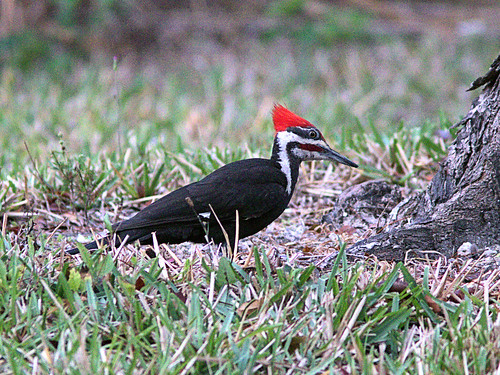
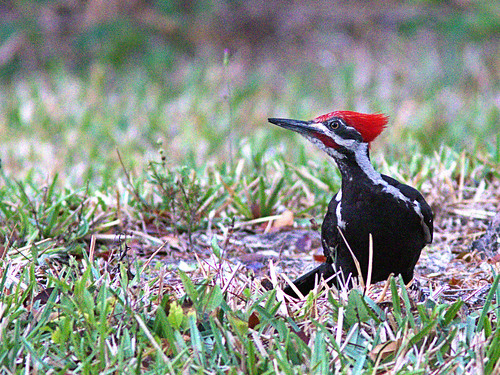
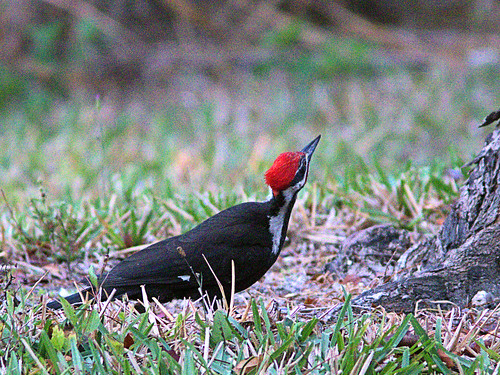
The Cattle Egret, pure white for most of the year, gave us a treat as it took on new bright orange plumes at the height of breeding season:
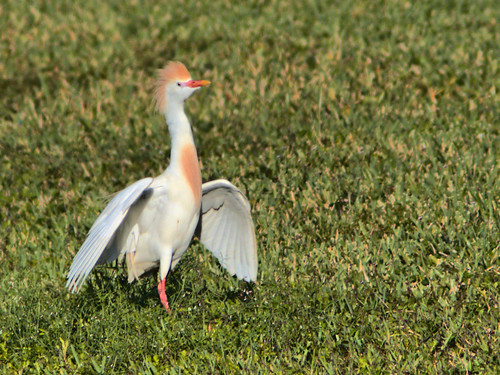
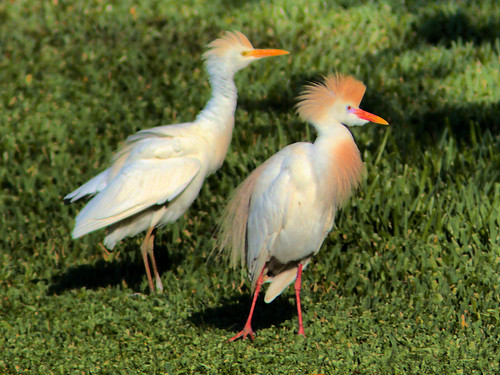
The Bald Eagle chicks escaped a threat to their safety. A major fire broke out in the Everglades Preserve, only about 3 miles west of our home. Smoke darkened the sky overhead until the winds shifted away from the nest area. This is the view from the site of the eagle nest:
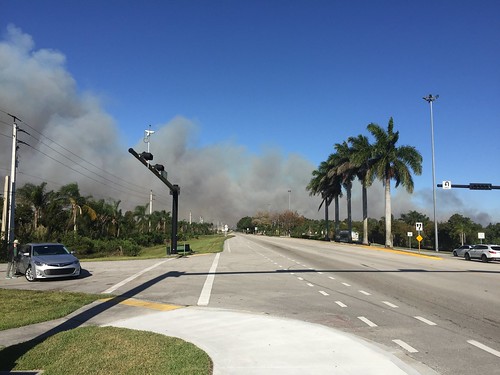
The eaglets are safe and sound. This is the larger of the two, probably a female and the older. Female Bald Eagles hatch from the first egg about three times more frequently than males and are larger than males in all stages of life:
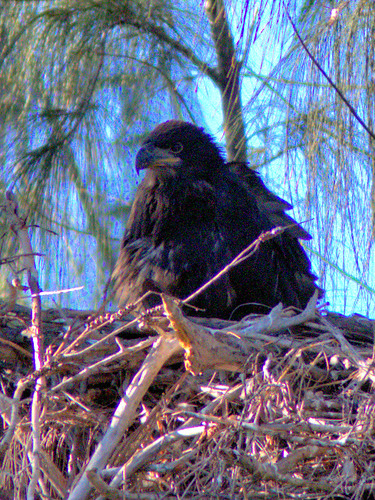
The female parent was roosting nearby. Her feathers are worn and stained:
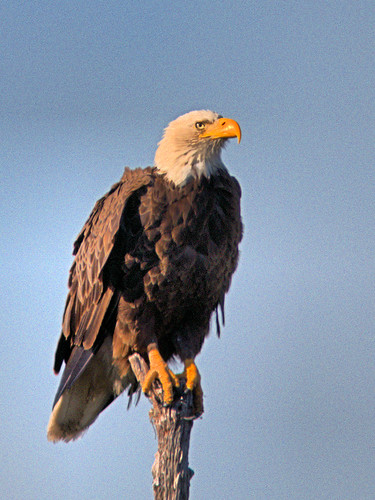
Common birds provide new perspectives on their beauty. A Killdeer wheels over the lake:
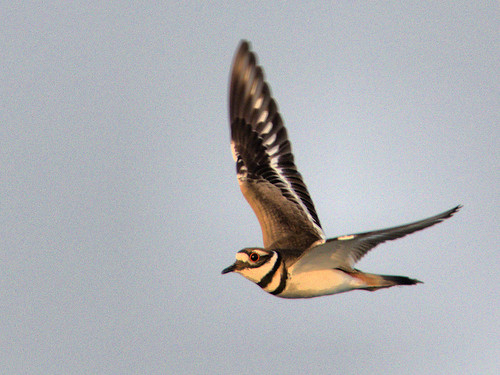
A Blue Jay musters its troops to gather and face some real or imagined threat:
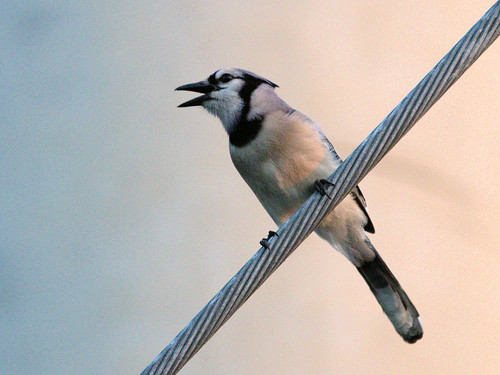
A close look at a Florida Tree Snail exposes its beauty. True jewels of nature, they may show all the colors of the rainbow, and no two are exactly alike:
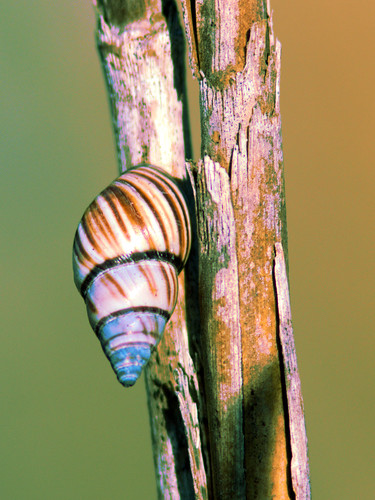
= = = = = = = = = = = = = = =
Linking to Misty's CAMERA CRITTERS,
Linking to BirdD'Pot by Anni
Linking to Wild Bird Wednesday by Stewart
Linking to Wordless Wednesday (on Tuesday) by NC Sue
Linking to Eileen's SATURDAY'S CRITTERS,
Linking to GOOD FENCES by Gosia
Linking to SKYWATCH FRIDAY by Yogi, Sylvia and Sandy
Linking to WEEKEND REFLECTIONS by James
Linking to ALL SEASONS by Jesh
________________________________________________
Please visit the links to all these memes to see some excellent photos on display
________________________________________________
This month I am perusing 415 images I processed in April, 2014 and looking for favorite memes: Birds and Critters, Reflections, views of the Sky, Fences, Seasons, and scenes which speak for themselves. I found examples of each, but, as usual, had to search for a fence (although a big lizard stole the show!)
Over the Easter holidays our daughter and family visited and we stayed a few nights on Sanibel Island on the Gulf of Mexico. Our two granddaughters enjoyed the respite from the cold weather back home in the Chicago area. There were fair skies over the mangroves at Ding Darling National Wildlife Reserve on Sanibel Island, Florida:
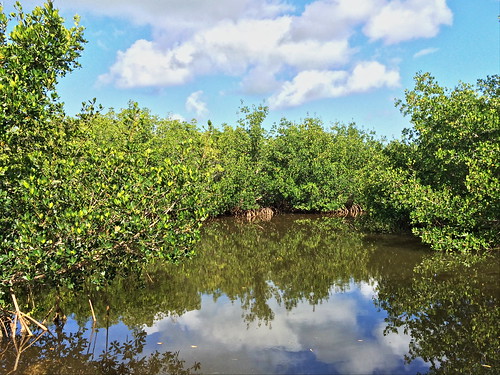
The month started off with good news about the two eaglets in the local Bald Eagle nest.
April 1, 2014 Honor and Glory were on nest, with Honor flapping her wings and ready to fly:
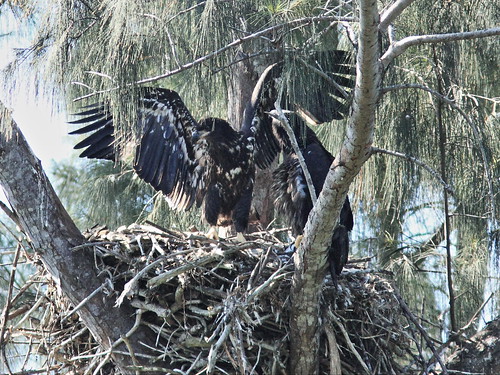
Glory was alone after Honor fledged (April 4)
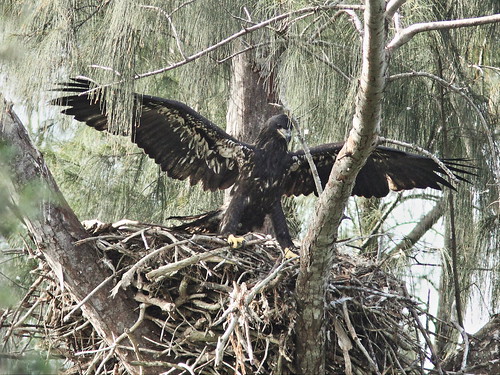
A pair of Red-bellied Woodpeckers interacted on the top of a dead palm tree:
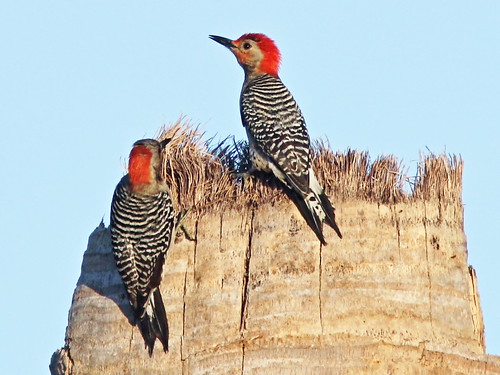
Least Terns arrived at the lake on April 5. They are a welcome sign of spring:
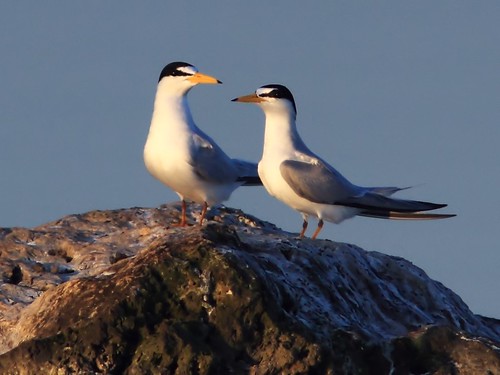
Looking west at sunrise over our local wetlands on April 4:
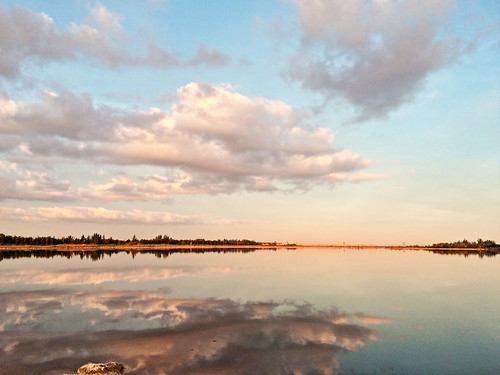
A Red-winged Blackbird cast a fine reflection on a calm morning:
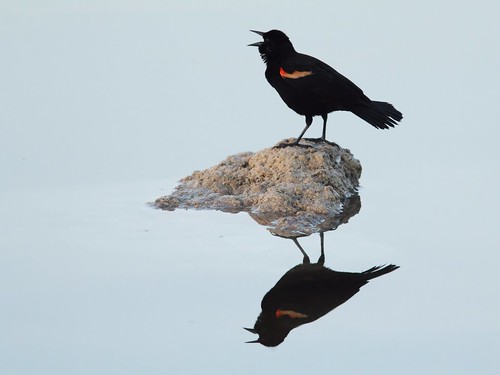
The only fence in the entire collection showed up in an April 18 photo I took while having lunch at Bass Pro Shop in Fort Lauderdale. The huge Green Iguanas have learned to beg for food from patrons on the deck. They are very demanding and actually can be a nuisance:
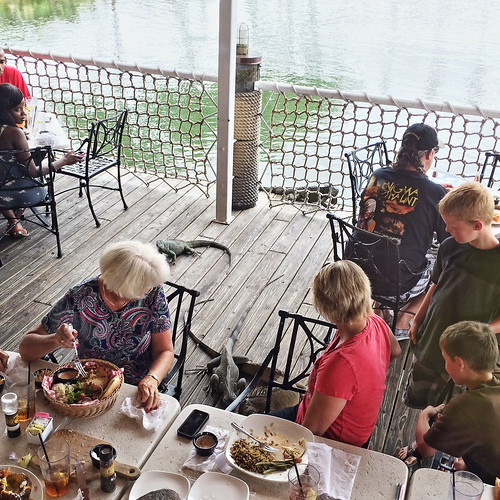
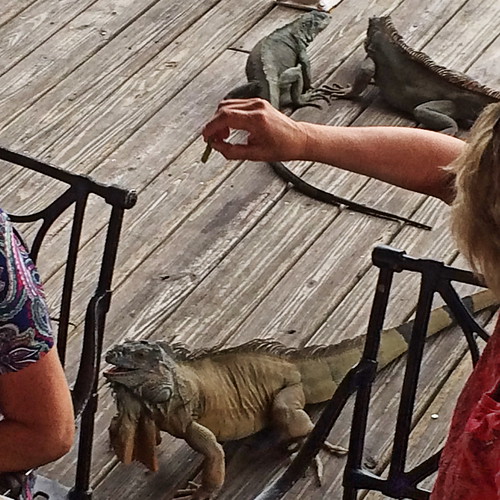
Another Green Iguana, this time in our own back yard:
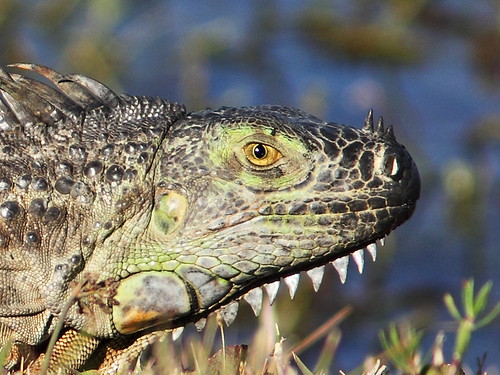
= = = = = = = = = = = = = = =
Linking to Misty's CAMERA CRITTERS,
Linking to Eileen's SATURDAY'S CRITTERS,
Linking to GOOD FENCES by Gosia
Linking to SKYWATCH FRIDAY by Yogi, Sylvia and Sandy
Linking to WEEKEND REFLECTIONS by James
Linking to BirdD'Pot by Anni
Linking to Wild Bird Wednesday by Stewart
Linking to Wordless Wednesday (on Tuesday) by NC Sue
Linking to ALL SEASONS by Jesh
________________________________________________
Please visit the links to all these memes to see some excellent photos on display
________________________________________________

























































